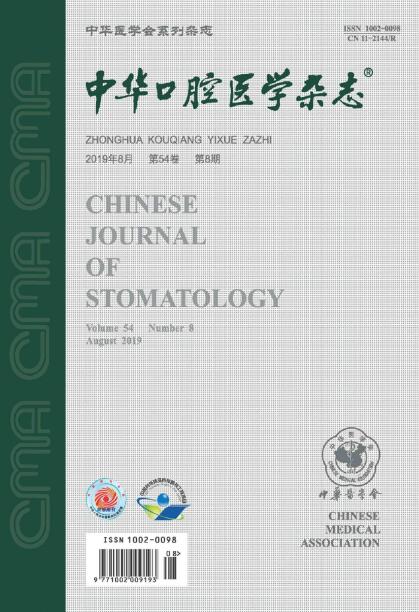锥形束CT不同视场下颞下颌关节图像的比较。
摘要
目的:观察比较不同扫描视场(FOV)在颞下颌关节(TMJ)锥形束ct成像中的应用,探讨不同CBCT扫描视场在颞下颌关节(TMJ)成像中的优缺点。目的为临床合理选择CBCT扫描视场进行颞下颌关节成像提供参考。方法:共46例颞下颌疾患患者[男22例,女24例;中位年龄24.5岁(范围:12-84岁)],于2023年1月至2025年1月从中国人民解放军总医院口腔颌面外科入组。所有患者均使用相同的CBCT设备Newtom 5G (QR S.r.l, Italy)对颞下颌关节进行大小视场的CBCT扫描,包括小视场(sFOV 6 cm×6 cm, 46例,92侧)和大视场(lFOV 15 cm×12 cm, 26例,52侧,20例,18 cm×16 cm, 40侧)。采用自匹配设计比较影像学参数(扫描时间、曝光时间、重建体素、辐射剂量、数据量)、图像质量和病变检测效果(关节面变平、表面糜烂、骨赘、皮质下硬化、皮质下囊肿、关节内钙化)。此外,还分析了关节间隙、髁突头高度和髁突高度的差异。结果:sFOV组扫描时间(72 s vs 24 s)和曝光时间(14.6 s vs 4.8 s)明显长于lFOV组,重建体素(0.15 mm vs 0.3 mm)明显小于lFOV组。sFOV组的辐射剂量[(199.94±5.52)mGy·cm]显著高于lFOV 15 cm×12 cm亚组[(96.20±25.34)mGy·cm, t=-20.29, Pt=-31.34, Pt=-16.75, Pt=214.49, PP=0.018],一致性Kappa系数为0.48。两组关节面扁平化检出率(80.43%,74/92)和骨赘检出率(55.43%,51/92)完全一致,Kappa系数为1。sFOV的皮质下硬化检出率(69.57%比68.48%)和关节内钙化检出率(5.43%比4.34%)略高,但无统计学意义(P>0.05), Kappa系数高,分别为0.93和0.88。对于皮下糜烂,sFOV检出率(38.04%,35/92)高于lFOV (26.09%, 24/92, Kappa=0.53,一致性中等),两者检出率差异无统计学意义(χ²=2.97,P=0.085)。两组间关节间隙和髁突头高度测量值差异无统计学意义(P < 0.05),但sFOV组髁突高度测量值显著大于lFOV组(t=4.52, P < 0.05)。结论:大FOV提供了广泛的解剖覆盖,优化了辐射剂量和数据处理效率,更便于TMJ的定量测量。小视场为显示微妙的髁突结构和病变提供了优越的分辨率。临床应根据检查目标个性化选择扫描场(大视场进行整体评估/定量分析;小FOV用于早期骨病变诊断),设备性能和患者特征。Objective: To observe and compare the application of different scanning fields of view (FOV) in cone beam CT (CBCT) imaging of the temporomandibular joint (TMJ), and to explore the advantages and disadvantages of different CBCT scanning FOV for TMJ imaging. The aim is to provide a reference for the rational selection of CBCT scanning FOV for TMJ imaging in clinical practice. Methods: A total of 46 patients with temporomandibular disorders [22 males, 24 females; median age 24.5 years (range from 12 to 84 years)] were enrolled from the Department of Stomatology,the First Medical Centre, Chinese PLA General Hospital, between January 2023 and January 2025. All patients underwent CBCT scanning of the temporomandibular joints with both large and small fields of view using the same CBCT device, Newtom 5G (QR S.r.l, Italy), including small-field-of-view (sFOV 6 cm×6 cm, 46 cases, 92 sides) and large-field-of-view (lFOV 15 cm×12 cm for 26 cases with 52 sides or 18 cm×16 cm for 20 cases with 40 sides). A self-matched design was used to compare imaging parameters (scan time, exposure time, reconstruction voxel, radiation dose, data volume), image quality, and lesion detection efficacy (articular surface flattening, surface erosion, osteophyte, subcortical sclerosis, subcortical cyst, intra-articular calcification). Additionally, differences in joint spaces, condylar head height, and condylar height were analyzed. Results: In the sFOV group, scan time (72 s vs. 24 s) and exposure time (14.6 s vs. 4.8 s) were significantly longer than those in the lFOV group, with smaller reconstruction voxels (0.15 mm vs. 0.3 mm). Radiation dose in the sFOV group [(199.94±5.52) mGy·cm] was significantly higher than that in the lFOV 15 cm×12 cm subgroup [(96.20±25.34) mGy·cm, t=-20.29, P<0.001] and the 18 cm×16 cm subgroup [(101.73±13.49) mGy·cm, t=-31.34, P<0.001]. In terms of data volume, the sFOV group [(274.18±1.74) MB] was larger than the lFOV 15 cm×12 cm subgroup [(208.83±20.13) MB, t=-16.75, P<0.001], while the lFOV 18 cm×16 cm subgroup [(386.39±1.63) MB] was significantly larger than the sFOV group [(274.83±1.78) MB, t=214.49, P<0.001]. sFOV images showed clearer anatomical margins, distinguishable trabecular bone, and fewer artifacts. The detection rate of subcortical cyst in the sFOV group (50.0%, 46/92) was significantly higher than that in the lFOV group (36.96%, 34/92, χ²=5.61, P=0.018), with a moderate agreement Kappa coefficient of 0.48. Detection rates of articular surface flattening (80.43%, 74/92) and osteophyte (55.43%, 51/92) were identical between groups, with a perfect agreement Kappa coefficient of 1. Detection rates of subcortical sclerosis (69.57% vs. 68.48%) and intra-articular calcification (5.43% vs. 4.34%) were slightly higher in sFOV but without statistical significance (P>0.05), with high Kappa coefficients of 0.93 and 0.88, respectively. For subcortical erosion, sFOV detection rate (38.04%, 35/92) was higher than lFOV (26.09%, 24/92, Kappa=0.53, moderate agreement), with no significant difference in detection rate (χ²=2.97, P=0.085). There were no statistical differences in joint space or condylar head height measurements between groups (P>0.05), but condylar height measurements in the sFOV group were significantly greater than those in the lFOV group (t=4.52, P<0.001). Conclusions: Large FOV provides wide anatomical coverage, optimizes radiation dose and data processing efficiency, and is more convenient for quantitative TMJ measurements.Small FOV offers superior resolution for displaying subtle condylar structures and lesions.Clinically, the choice of scan field should be individualized based on examination objectives (large FOV for holistic assessment/quantitative analysis; small FOV for early bone lesion diagnosis), equipment performance, and patient characteristics.

 求助内容:
求助内容: 应助结果提醒方式:
应助结果提醒方式:


